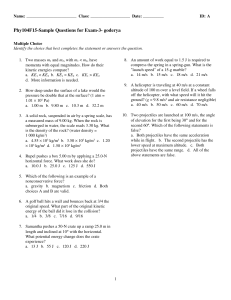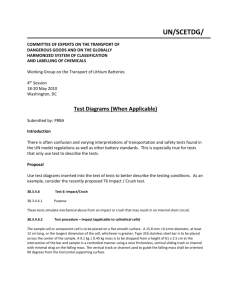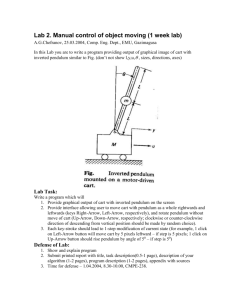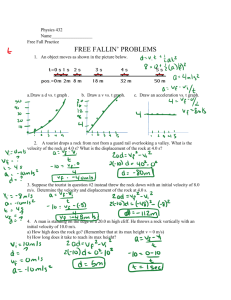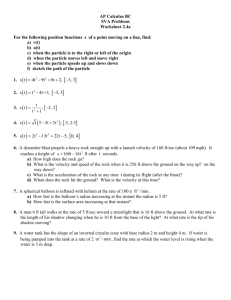Chapter6Clickers
advertisement
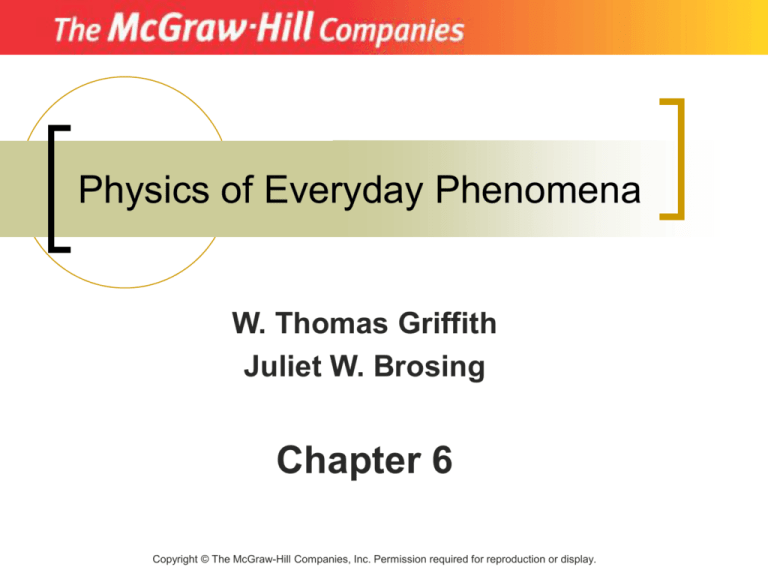
Physics of Everyday Phenomena W. Thomas Griffith Juliet W. Brosing Chapter 6 Copyright © The McGraw-Hill Companies, Inc. Permission required for reproduction or display. Question 6.1 A crate is being pushed with a constant horizontal force, F. Four forces can be identified: 1) F, 2) the gravitational force, 3) the normal force, and 4) the frictional force. Which forces do NO work on the crate? A) 1 & 4 B) 2 & 3 C) 2 & 3 & 4 D) 1 & 2 & 3 Question 6.2 If an equivalent amount of work is done in a shorter period of time A) more power is required B) the same amount of power is required C) less power is required Question 6.3 If objects A and B have the same mass, but object B has 9X the kinetic energy of object A, what is true of their speeds? A) vB = 9vA B) vB = 3vA C) 9vB = vA D) 3vB = vA Question 6.4 Compare the kinetic energy of two balls: ball 1: mass m thrown with speed 2v ball 2: mass 2m thrown with speed v A) B) C) D) KE1 = 4KE2 KE1 = KE2 2KE1 = KE2 KE1 = 2KE2 Question 6.5 A cart starts with velocity v and rolls up the frictionless path shown. At what point is the kinetic energy greatest? A) 1 B) 2 C) 3 D) 4 Question 6.6 A truck, initially at rest, rolls down a frictionless hill and attains a speed of 20 m/s at the bottom. To achieve a speed of 40 m/s at the bottom, how many times higher must the hill be? A) half the height B) the same height C) 12 times the height D) twice the height E) four times the height Question 6.7 Potential energy is energy that an object possesses because of its A) position B) motion C) temperature D) conductivity Question 6.8 A cart starts with velocity v and rolls up the frictionless path shown. At what point is the potential energy greatest? A) 1 B) 2 C) 3 D) 4 Question 6.9 If the height of an object above a reference level is quadrupled its gravitational potential energy is multiplied by A) 16 B) 4 C) 1/4 D) 1/16 Question 6.10 Suppose that a given amount of work is required to crush an aluminum can and you can crush a can by dropping a rock on it from height h on the Earth. On the moon, from approximately what height must you drop the same rock to crush a can? A) h B) 3h C) 6h D) 9h Question 6.11 Suppose that you can crush an aluminum can by dropping a rock of mass m on it from a height h. Which of the following scenarios would crush two cans? A) dropping a rock of mass 2m from height h B) dropping a rock of mass m from height 2h C) dropping a rock of mass 1/2m from height 4h D) all of the above E) none of the above Question 6.12 The principle of conservation of energy states that if the total mechanical energy is a constant then A) the momentum is always a constant B) no work is done on a system by any nonconservative forces C) no work is done on a system by any forces D) work is done on a system in order to conserve energy Question 6.13 A cart starts with velocity v and rolls up the frictionless path shown. At what point does the cart have the greatest total energy? A) 1 B) 2 C) 3 D) 4 E) all the same Question 6.14 Can the total mechanical energy E = KE + PE ever be negative ? A) Yes, always. B) Yes, because KE can be negative. C) Yes, because PE can be negative. D) No. Question 6.15 Which path correctly indicates the motion of the pendulum bob after the string is cut when the pendulum is at the bottom of its swing? A. A B. B C. C Question 6.16 Which path correctly indicates the motion of the pendulum bob when it is cut at the instant it is at the top of its swing? A. A B. B C. C D. D Question 6.17 If the distance a spring is stretched from its equilibrium position is halved the potential energy of the spring is multiplied by A) 4 B) 2 C) 0.5 D) 0.25 Question 6.18 Simple harmonic motion A) occurs when there are no forces on the system B) requires a constant force C) requires a force which is not constant, but varies directly with position D) requires a force which is not constant, but varies inversely with position Question 6.19 A mass suspended from a spring moves with the greatest velocity A) at the end points of its motion B) at the equilibrium position C) midway between the end point of its motion and the equilibrium position Answer Key to Chapter 6 1) 2) 3) 4) 5) 6) 7) 8) 9) 10) B A B D A E A D B C 11) 12) 13) 14) 15) 16) 17) 18) 19) D B E C C B D C B
